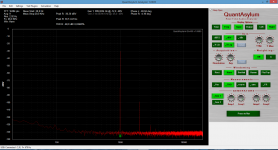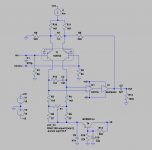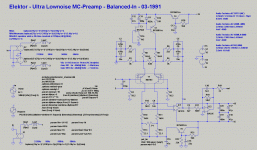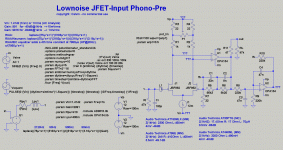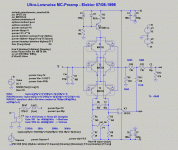Yes, could be done that way. Calvin has shown an even better implementation somewhere.
I measured again and found a little hum loop.
I measure 13.5mV now. OK, that is not much less then 14mV.
I build the other channel with FZT653, 753 ( this are the lowest noise i found so far ) and the reading was 13.5mV too.
So we have a patt situation.
The new ones have higher Hfe though. I measured around 490 in the PNP and 650 in the NPN.
That may matter when go go into the bases and want the lowest input offset.
I have shown a method in the Paradise how to trim the input offset so this is not a real problem.
In some circuits high Hfe brings better linearity but i do not think that distortion matters much at such low level of an MC input provided that the topology choosen is not grossly incompetent.
The old ones have advantages too.
They have very high early voltage and can stand up to 100V.
PNP and NPN are very*symetrical.
The only disadvantage is lower Hfe.
I measure around 160.
I measured again and found a little hum loop.
I measure 13.5mV now. OK, that is not much less then 14mV.
I build the other channel with FZT653, 753 ( this are the lowest noise i found so far ) and the reading was 13.5mV too.
So we have a patt situation.
The new ones have higher Hfe though. I measured around 490 in the PNP and 650 in the NPN.
That may matter when go go into the bases and want the lowest input offset.
I have shown a method in the Paradise how to trim the input offset so this is not a real problem.
In some circuits high Hfe brings better linearity but i do not think that distortion matters much at such low level of an MC input provided that the topology choosen is not grossly incompetent.
The old ones have advantages too.
They have very high early voltage and can stand up to 100V.
PNP and NPN are very*symetrical.
The only disadvantage is lower Hfe.
I measure around 160.
Last edited:
Yes, could be done that way. Calvin has shown an even better implementation somewhere.
I would like to see that 🙂 CALVIN!!! where are you ... 🙂
I compared both channels with other measurements too.
One channel goes to 1,6MHz ( - 3dB ), the other channel with the older Zetex to 1,8MHz
( -3dB ) so the old ones are a bit faster but not much.
I measured untrimmed input offset :
20uV into 6 Ohm on both channels.
No advantage for the high Hfe in my circuit.
Then on the distortion analyser :
The old ones have 5 times less distortion then the new ones !
Measurements are at 30mV but i see that phenomenon at other volumes too.
I did not show the measurements on the curve tracer.
Here the "old" ones have much higher early voltage at the idle chosen and they are totally symmetric.
Both transistor types show good quasi saturation behaviour.
Conclusion : The old king is the new king.
I will now put the pre-pre in my system. Old ones in one channel, new ones in the other.
I know, this is a bit weired but i try.
One channel goes to 1,6MHz ( - 3dB ), the other channel with the older Zetex to 1,8MHz
( -3dB ) so the old ones are a bit faster but not much.
I measured untrimmed input offset :
20uV into 6 Ohm on both channels.
No advantage for the high Hfe in my circuit.
Then on the distortion analyser :
The old ones have 5 times less distortion then the new ones !
Measurements are at 30mV but i see that phenomenon at other volumes too.
I did not show the measurements on the curve tracer.
Here the "old" ones have much higher early voltage at the idle chosen and they are totally symmetric.
Both transistor types show good quasi saturation behaviour.
Conclusion : The old king is the new king.
I will now put the pre-pre in my system. Old ones in one channel, new ones in the other.
I know, this is a bit weired but i try.
I compared both channels with other measurements too.
One channel goes to 1,6MHz ( - 3dB ), the other channel with the older Zetex to 1,8MHz
( -3dB ) so the old ones are a bit faster but not much.
I measured untrimmed input offset :
20uV into 6 Ohm on both channels.
No advantage for the high Hfe in my circuit.
Then on the distortion analyser :
The old ones have 5 times less distortion then the new ones !
Measurements are at 30mV but i see that phenomenon at other volumes too.
I did not show the measurements on the curve tracer.
Here the "old" ones have much higher early voltage at the idle chosen and they are totally symmetric.
Both transistor types show good quasi saturation behaviour.
Conclusion : The old king is the new king.
I will now put the pre-pre in my system. Old ones in one channel, new ones in the other.
I know, this is a bit weired but i try.
One channel goes to 1,6MHz ( - 3dB ), the other channel with the older Zetex to 1,8MHz
( -3dB ) so the old ones are a bit faster but not much.
I measured untrimmed input offset :
20uV into 6 Ohm on both channels.
No advantage for the high Hfe in my circuit.
Then on the distortion analyser :
The old ones have 5 times less distortion then the new ones !
Measurements are at 30mV but i see that phenomenon at other volumes too.
I did not show the measurements on the curve tracer.
Here the "old" ones have much higher early voltage at the idle chosen and they are totally symmetric.
Both transistor types show good quasi saturation behaviour.
Conclusion : The old king is the new king.
I will now put the pre-pre in my system. Old ones in one channel, new ones in the other.
I know, this is a bit weired but i try.
Attachments
I made another interesting experiment. Some time ago here was a LONG discussion about what is the optimum idle for lowest voltage noise. One formular came from John Curl, the other from syn08. Following syn08 considerable idle is better. Something like 20mA per transistor and even more when it is a super low Rbbe`type. That erodes in theory the influence of the idle on the voltage noise and only Rbbe`remains. So i cranked it to 20mA per transistor coming from ca. 7mA. The readings got worse! A lot, from 13.5mV to double. Why can that be?
Furtunately i had a talk with Burkhard Vogel and he told me that too high idle shifts the 1/F corner upwards in frequency. In my setup i measure down to 9Hz ( -3dB ) and my reading should capture some of the increased low frequency noise because of that shifting phenomenon. Burkhard is preparing an article on that to be published in Linear Audio i think. My conclusion is that for the Zetex shown here the ideal compromise is between 5 - 10mA per device.
Furtunately i had a talk with Burkhard Vogel and he told me that too high idle shifts the 1/F corner upwards in frequency. In my setup i measure down to 9Hz ( -3dB ) and my reading should capture some of the increased low frequency noise because of that shifting phenomenon. Burkhard is preparing an article on that to be published in Linear Audio i think. My conclusion is that for the Zetex shown here the ideal compromise is between 5 - 10mA per device.
Last edited:
I run the OLD-new kings at 15 ma for two sets, all is very stable, noise is incredible low (so is HUM). I have compared to the likes of Solution and ARC, this is by a long way much much quieter. BTW i lowered the treble response app 0.25dB, didn't expect so dramatic an increase in coherence. if i had done the same on a pair of speakers I would newer have noticed.
Yes, we make lower noise here then virually the whole industry.
When AD797 is the end of the story why bother anyway.
I heard your design ( with my input ) on the High End in Munich.
ERRRR: i DID NOT HEAR IT.
Damn, that thing is quiet.
Hum is not an option anyway but there also was no hiss to talk about.
I think we solved that problem satisfactory and i knew.
But now that i can measure it i am even more confident that we did make the right choices.
When AD797 is the end of the story why bother anyway.
I heard your design ( with my input ) on the High End in Munich.
ERRRR: i DID NOT HEAR IT.
Damn, that thing is quiet.
Hum is not an option anyway but there also was no hiss to talk about.
I think we solved that problem satisfactory and i knew.
But now that i can measure it i am even more confident that we did make the right choices.
Going back to vinyl after several weeks is quite a shock.
I had listened to CD for a while because i designed two preamps ( one doubles as a headphone amp ) and i also compare to Frans Companion design.
By the way, i have no problem with digital sound.
At it´s best it is cleaner and more stable then vinyl.
What vinyl has though in spades is that ( how shall i call it ) emotion ?
In my system it is bigger in size, more opulent if you wish.
OK, bass is not that tight but nevertheless satisfying.
What i really need is a good subsonic filter.
Maybe i design one.
I would do it a bit different, with mono mix in the deep bass and such.
I had listened to CD for a while because i designed two preamps ( one doubles as a headphone amp ) and i also compare to Frans Companion design.
By the way, i have no problem with digital sound.
At it´s best it is cleaner and more stable then vinyl.
What vinyl has though in spades is that ( how shall i call it ) emotion ?
In my system it is bigger in size, more opulent if you wish.
OK, bass is not that tight but nevertheless satisfying.
What i really need is a good subsonic filter.
Maybe i design one.
I would do it a bit different, with mono mix in the deep bass and such.
Here is an interesting thread about the rumble problem and how to solve it.
The circuit could be used as a start.
The author puts that box between the phono and the preamp.
I think that is a good idea plus a bypass switch.
The circuit could be used as a start.
The author puts that box between the phono and the preamp.
I think that is a good idea plus a bypass switch.
Yes, Sergio.
The feddback goes to the emitters and it is PNP so potentially a bit lower noise.
The feddback goes to the emitters and it is PNP so potentially a bit lower noise.
Hi,
The Elektor Preamp from 11-12/1986 featured a triplet of MAT02 and a OP-27.
The dimensioning of the parts is the same as in Sergio Franco´s Book about OP-Amps (where the Fig reads "Courtesy of Precision Monolithics").
The OP27 (A and E) specs:
Aol: 125dB, Enw(1kHz): 3nV/sqr(Hz) 1/f: 2.7Hz, Inw: 0.4pa/sqr(Hz) 1/f: 140Hz, GBP: 8MHz, CMRR: 126dB , dVos/dT: 0.2µV/C°
The hybrid circuit specs:
Aol: 150dB, Enw(1kHz): 0.5nV/sqr(Hz) 1/f: 1.5Hz, Inw: 1.5pa/sqr(Hz), GBP: 150MHz, CMRR: 130dB , dVos/dT: 0.1µV/C°
The hybrid structure was chosen again for an Elektor MC-Preamp (3/1991), but this time with balanced PNP-Input.
I´m thinking about a mixture of the 1986/1991 circuits using NJFETs instead of the NPNs, to get rid of the big input coupling caps.
A topology used for example in the Pioneer C73 Preamp and more elaborated in their C90/C91.Yamaha and other japanese companies also used the JFET-OPAmp topology quite often in their 80s and 90s PreAmps.
The latest Elektor-incarnation was a single ended input with a PNP-triplet in 7-8/1998.
jauu
Calvin
ps. Joachim those Zetex transistors have wquite high input capacitances.
Maybe the source of the higher THD.
Have You by chance taken a look at the SOT23 FMMT617/717 from Zetex?
Their Spice Models show very low Rbe values.
The Elektor Preamp from 11-12/1986 featured a triplet of MAT02 and a OP-27.
The dimensioning of the parts is the same as in Sergio Franco´s Book about OP-Amps (where the Fig reads "Courtesy of Precision Monolithics").
The OP27 (A and E) specs:
Aol: 125dB, Enw(1kHz): 3nV/sqr(Hz) 1/f: 2.7Hz, Inw: 0.4pa/sqr(Hz) 1/f: 140Hz, GBP: 8MHz, CMRR: 126dB , dVos/dT: 0.2µV/C°
The hybrid circuit specs:
Aol: 150dB, Enw(1kHz): 0.5nV/sqr(Hz) 1/f: 1.5Hz, Inw: 1.5pa/sqr(Hz), GBP: 150MHz, CMRR: 130dB , dVos/dT: 0.1µV/C°
The hybrid structure was chosen again for an Elektor MC-Preamp (3/1991), but this time with balanced PNP-Input.
I´m thinking about a mixture of the 1986/1991 circuits using NJFETs instead of the NPNs, to get rid of the big input coupling caps.
A topology used for example in the Pioneer C73 Preamp and more elaborated in their C90/C91.Yamaha and other japanese companies also used the JFET-OPAmp topology quite often in their 80s and 90s PreAmps.
The latest Elektor-incarnation was a single ended input with a PNP-triplet in 7-8/1998.
jauu
Calvin
ps. Joachim those Zetex transistors have wquite high input capacitances.
Maybe the source of the higher THD.
Have You by chance taken a look at the SOT23 FMMT617/717 from Zetex?
Their Spice Models show very low Rbe values.
Attachments
Last edited:
Hi Frans !
I found Calvins version.
Looks nice, I will try/sim it 🙂
